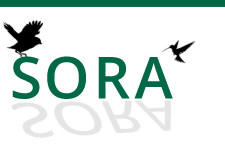More about the White Pelican on the Texas Coast
Online Full Text
Since writing the little story which appeared in the July issue of the Condor regarding the nesting of White Pelicans (Pelecanus ergthrorhynchos) on the Texas coast, further observations have been made, an account of which may be of interest as supplemental to the original Story.
Naturally I was eager to find how the colony was faring this year, and the morning of May 25 found me on my way to North Bird Island. I was not prepared, however, for the thrilling spectacle that awaited us as we landed. The island was literally white with breeding pelicans-acres of them. My estimate of adult birds was five thousand. The friend who accompanied me, and the boatman, insisted that there were twice that number. They were arranged in four major areas and a number of smaller ones, the largest being at the south end of the island as in 1929. The nests were placed near together and were poorly and, apparently, hastily built. The composition was nearly altogether of sticks and weeds with practically no mound of sand and shell, and they were not nearly so large as the average nest of the Brown Pelican. By the way, there were six nests of the latter in the colony. Most of the nests contained one or two eggs. A very few held young apparently two weeks old and other nests contained young newly hatched. The number of dead chicks lying about was large. One lone Caracara was the only scavenger observed.
I was disappointed in being unable to remain on the island for more than two or three hours. Notwithstanding the birds being unusually fearless they were too much disturbed by our presence to permit observation of their feeding habits. Later in the day while on our way to the larger South Bird Island we saw company after company of White Pelicans headed for their nesting colony and I think it fair to assume that some of them were carrying food to their young and others were on their way to relieve their mates in the duties of incubation. Late in the afternoon we were in the same vicinity and saw them leaving the island in precisely the same order as we had seen them approach it.
This pelican, being a surface feeder and not a plunger like his brown cousin, feeds in the shallow inlets of Laguna Madre, teeming with small fish, below South Bird Island. Not one White Pelican was seen north of North Bird Island. The thing that impressed me most was that they were gregarious in their coming and their going from the nesting place. They moved in companies of seventy-five or one hundred, not a great distance over the water, and in lines so uniform as to do credit to a comnans of West Point cadets. Not half a dozen isolated birds were seen. I might add that not a single White Pelican was on South Bird Island and the brown variety had been reduced to about thirty pairs, the smallest number that has bred there for years. Has the coming of the larger species in such great numbers affected the abundance of the smaller?
Houston, Texas, August 5, 1930
Creative Commons License
Recommended Citation
Carroll, J. J.
(1930)
"More about the White Pelican on the Texas Coast,"
Condor: Vol. 32
:
Iss.
6
, Article 18.
Available at:
https://digitalcommons.usf.edu/condor/vol32/iss6/18

